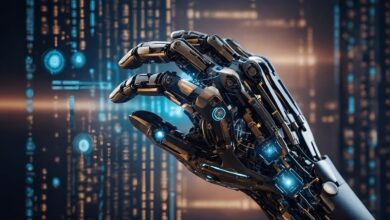
AI image generation and Text Production are two AI content production tools available today. These tools allow users to create high-quality images and text with minimal effort quickly. However, the use of these tools can have serious implications for copyright issues, as they can be used to generate content that infringes on the copyright of others.
AI image generation is a technology that uses machine learning algorithms to generate images automatically. This technology can potentially revolutionize how we create and use digital images, but it also raises some questions about copyright protection.
Over the past ten years, AI Image Generator has evolved and attracted a crescendo of attention thanks to the usage of machine learning (ML) and artificial intelligence. These innovations sparked people’s imaginations and hinted at a coming technological revolution. A branch of AI and ML called “generative AI” has gained enormous traction in recent months. Google Trends shows a tenfold growth in “generative AI” search volume since June 2022.
AI-generated images are used in creative works like art and for commercial purposes such as advertising or product design. With this comes a need for legal protection of the rights of creators, who may find their work copied or misused without their permission. We must consider how copyright law can be adapted to protect AI-generated images from unauthorized use and copying.
How do AI Image Generators work?
Like other ML and AI technologies, generative AI makes use of vast quantities of data to essentially carry out pattern detection. You may manually enter the data or use automatic scraping applications to obtain it from sources like the web.
Since manually entering training data might take excessive time, many algorithms choose the latter strategy. For AI algorithms that create images, the data consists of an image and any context or descriptors related to it. The AI software runs a series of algorithms to link data points and identify trends once a significant amount of data has been gathered.
The trained AI software will then compare the user’s fresh input—such as a string of text—with its database of text data and interpolate related image data to generate an output. The specific algorithm utilized determines how the work is generated.
Both Stable Diffusion and DALL-E 2 uses “diffusion models,” “which first add noise (visual static) to the training pictures and then undo the noising process to return to the original image.” New pictures are created by applying the denoising technique to randomly sampled noise.
The impact and concern about copyright protection
A wide range of moral and ethical questions have been raised about generative AI, as with other new technology. The visuals that can be created utilizing this technology are mostly in doubt because of ethical concerns. On the other hand, the production and usage of the photos are at issue in legal disputes. The issue, therefore, becomes whether utilizing pictures protected by copyright to train an AI algorithm complies with the fair use concept.
The visuals created by generative AI could violate other people’s copyrights. It’s probable that a produced picture will resemble the original work too closely because some created images will probably use copyrighted material as training data.
The U.S. Copyright Office has claimed that AI work without a component of “human authorship” is not protected and cannot be registered; this judgment is currently being revised in federal court.“computer-generated”, in relation to a work, means that the work is generated by computer in circumstances such that there is no human author of the work” — Section 178, CDPA 1998.
The resulting work should be covered by copyright as long as AI-generated art is only utilized as a springboard for further creative development by a human artist. But be aware that you could not have any legal remedy if someone subsequently copies your art if AI created it without any human input. The terms of service for an image-generating tool may further restrict your legal rights.
The use of AI-generated art raises a wide range of ethical and moral issues, mainly when the technology is used to create products that are intentionally created to imitate the aesthetics of active human artists without acknowledgement or payment. There are many circumstances in which a designer would desire to incorporate a particular copyrighted work that requires clearance. Using AI techniques to intentionally make knockoffs involves significant drawbacks. These problems aren’t being minimized; they’re just not the article’s main topic
Is AI-Generated Art Copyright Infringement?
Definitely a YES, using AI-generated art as a license-free substitute for films and other commercial projects is only a practical choice, provided the finished piece of art doesn’t violate a previously published work that is protected by copyright.
DALLE’s research lab, OpenAI, claims to have trained the tool by scraping and studying more than 650 million annotated photos, but the company’s data is private. However, Stability.AI, the business that developed Stable Diffusion, a rival to DALLE, has made the data required to train their software openly accessible.
Similarly to this, AI technologies replicate photographs less to access their creative expression and more to find patterns in the pictures and descriptions. The utilization of AI-copyrighted content is even more revolutionary than Google Book Search.
A major portion of the 600 million photos used to train Stable Diffusion was derived from websites like Pinterest and Fine Art America, according to Andy Baio, a technologist who examined 12 million of those images.
Implications for copyright law
Artificial intelligence’s use in the creation of works may have significant effects on copyright legislation. Because the software was only a tool to facilitate the creative process, much like a pen and paper, copyright ownership in computer-generated works was traditionally not in doubt. Copyright laws and most definitions of originality call for a human creator to protect original creative works.
The computer program, however, is no longer a tool with the most recent forms of artificial intelligence; instead, it actually makes many of the decisions involved in the creative process without human input and the majority of legal systems, including Spain, UK and Germany, stipulate that only works produced by humans are eligible for copyright protection.
There are two mixed legal implications in this copyright issue. It can either refuse to grant copyright protection to works produced by computers or claim authorship of works belonging to the program’s developer.
Who has the ownership or is entitled to be copyrighted?
In light of this, the issue of who the law would regard as the person making the arrangements for the work to be cremated remains unanswered.
Should the law acknowledge the owner of the application or its generator for their contribution? According to the understanding, this is equivalent to questioning whether the producer of a pen or the author should be granted a copyright. Or consider a situation where an artist creates a work of art with Photoshop.
Photoshop was created by Adobe, however it is obvious that Adobe did not own each and every piece of art made using it. The user, or the author who used the application to make their work, is the owner of the copyright. However, when it comes to AI algorithms that can produce art, the user’s involvement in the creative process may be as simple as pressing some buttons to let the machine do its thing, or like ChatGPT, which leverages the user’s input prompts to develop a corresponding painting.
So with that, we can say without the help of the user’s prompt, an AI-generated image cannot generate what users need without a prompt. This aspect is clear that the copyright should be subjected to the artist and not the AI.
Although, there’s still no legal conclusion regarding the ownership of who owns the generated piece, either the software or the generator. But, if proper justification is to come out, there is more chance of subjecting ownership to the generator.
Why we await a legal statement regarding that, should we stop using it? Definitely NO. There are some tips and advice that can keep you safe both for personal and commercial use in order to avoid infringement.
Tips for Avoiding Copyright Infringement When Using AI-Generated Art
As these technologies have not been extensively tested in any courts, the implications connected with utilizing them to create art are now mostly unclear. Here are things to do and things to avoid when using AI-Generated Art:
- Think twice before utilizing any artist’s name or creation in the creation of artwork, especially if a copyright license still covers it without being aware of the precise instruments and instructions attached.
- Although these tools may be simple to use, they do include terms of service, licensing agreements, and the like. Knowing what you can and cannot do when using a tool is crucial because if you break the rules, your use of the device may be terminated, or accused of infringing the rights of the tool’s creator.
- Even if an image created by one of these AI tools doesn’t resemble any existing images significantly, the resulting output may violate one of the protected components contained in the current work. So refrain from creating a popular image or utilizing popular prompts.
- Make sure that the terms of service for your AI tool permit the commercial usage of the generated photos.
- For style or prompt descriptions, use suggestions that are somewhat not general.
- Utilize tools for reverse image search to verify outcomes. e.g Google Lens or Google Reverse Image.
- The prompt that was used to generate each image you produce should be saved in the metadata or filename of the image file for future reference.
- In your prompts, avoid mentioning already published works or characters that are protected by copyright.
- Uploading existing reference photos is prohibited unless you own the copyright to them.
- We know most AI Image Generators still stand on their terms that all generated images are free to use, but better still, when using them, reference the image to the platform of the creator.
The future
The boundary between artwork created by a person and a computer will likely grow even hazier as more artists use artificial intelligence and machines get better at generating creative works.
The most logical course of action seems to be to provide copyright to the individual who generated the art rather than the program or instrument utilized.
There are more big debates to come as this technology advances. Still, we seek the legal clearance for the existing issues of copyright and the implications attached because many people out there are interested in the technology but might not be aware of the legal implications or might even be afraid to use them.





